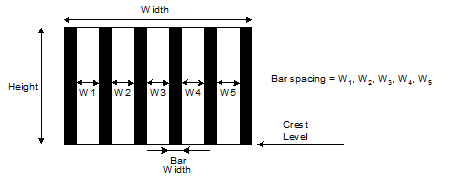Screens
InfoWorks ICM allows sloping bar screens to be included in the network. A screen is used to trap debris in the network, possibly at the entrance to a treatment works.
The calculation method uses the Kirschmer formula, which is appropriate for clean screens, and calculates headloss due to the bar screens only. It does not replace or include for the significant headlosses that would be associated with changes in channel geometry/bed level.
For screens that are partially blocked it may be more appropriate to use a User-Defined Control and define a Head Discharge Table to represent the screen.
The Kirschmer formula is:
|
|
where
where: Dh is the head difference from upstream to downstream v is the velocity g is the acceleration due to gravity k is the headloss coefficient Ck is Kirschmer's Coefficient (representing bar shape) a is the screen angle to the vertical w is the bar width S is the bar spacing |

This is implemented in the simulation engine as:
|
|
where
where: Q is the discharge Cd is the discharge coefficient b is the width of the screen (including bars and bar spaces) h1 is the upstream depth with respect to the crest (the base of the screen) h2 is the downstream depth with respect to the crest (the base of the screen)
Note: Equation (3) assumes h2 >= 0, so if the downstream level is below the crest, the equation becomes the free weir flow equation:
|
Villemonte Equation
The screen is assumed to be drowned if the downstream water level exceeds the crest level. If the Use Villemonte equation has been chosen as a Simulation Parameter, when the screen is under drowned conditions, the Villemonte formula is used to modify the free discharge:
|
|
where: Q is the discharge Q0 is the free discharge Du is the upstream depth with respect to the crest Dd is the downstream depth with respect to the crest |
